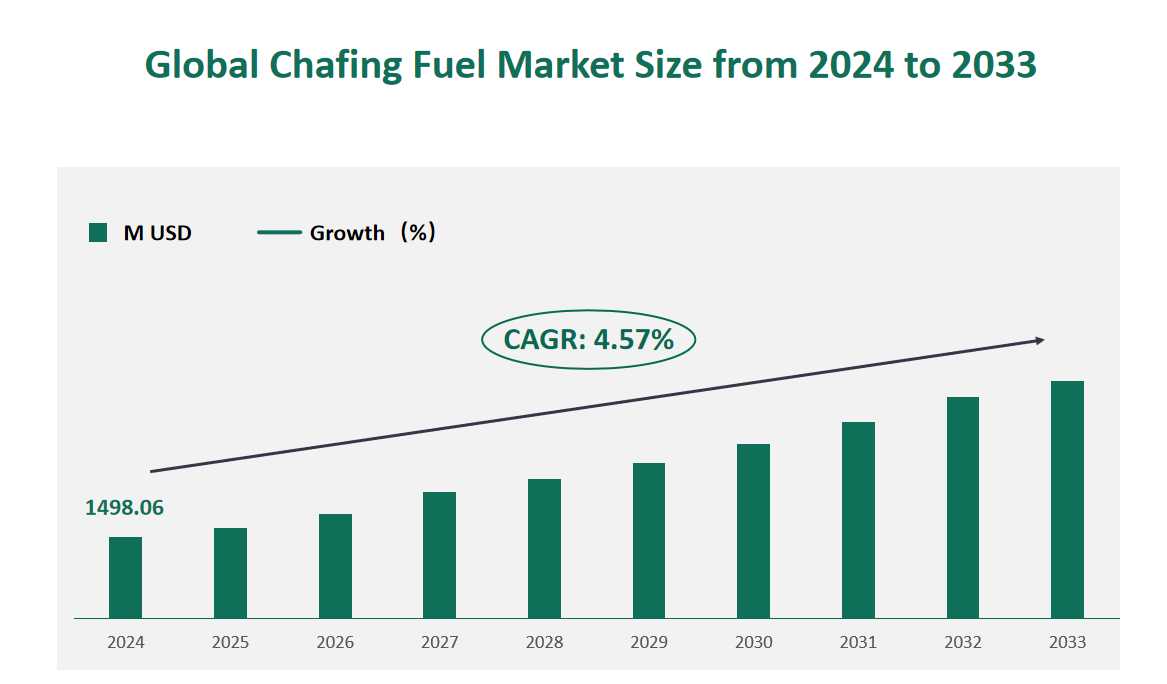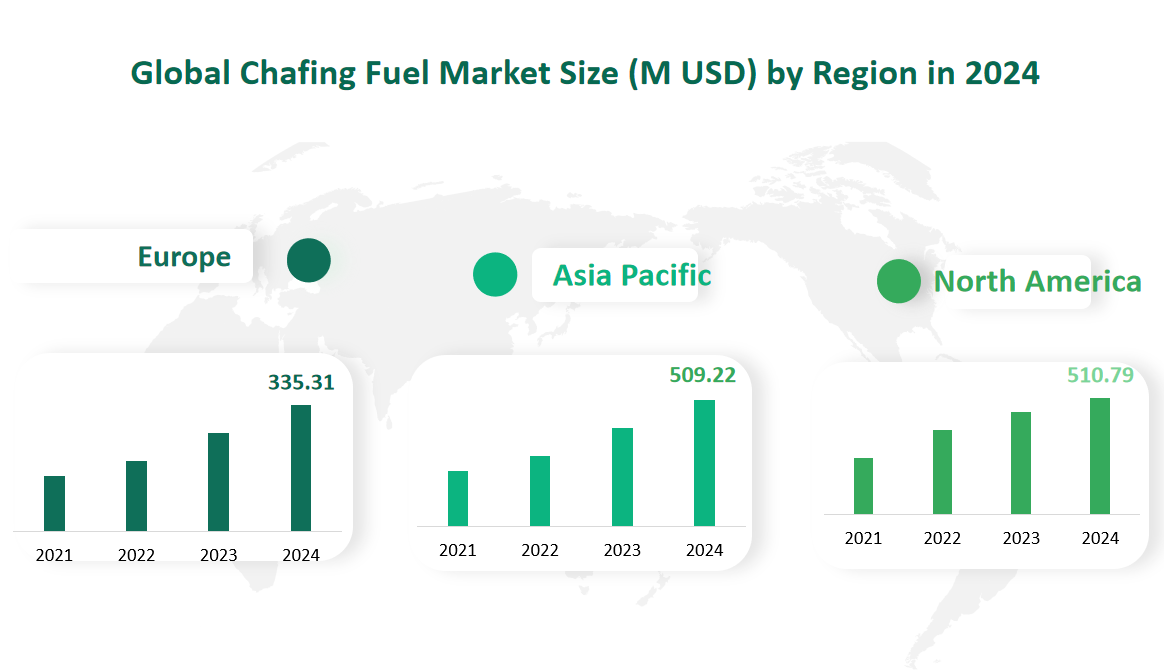1 Global Chafing Fuel Market Size (Value) and CAGR (2024-2033)
In 2024, the global Chafing Fuel market was valued at USD 1498.06 million, with a CAGR of 4.57% from 2024 to 2033.
Chafing fuel, defined as a combustible substance used to heat food and maintain serving temperatures, is primarily sold in small jars and is burned directly, either with or without a wick. The fuel typically contains methanol, ethanol, diethylene glycol, and other compounds that allow for safe indoor burning with minimal soot or odor production.
Figure Global Chafing Fuel Market Size (M USD) and CAGR 2024-2033

2 Chafing Fuel Market Growth Drivers and Industry Trends
The chafing fuel market is experiencing a phase of significant growth, propelled by a multitude of drivers and industry trends. One of the primary growth catalysts is the increasing demand from the catering industry, which relies on chafing fuel to maintain optimal food serving temperatures and extend the display and service time of food. This demand is further amplified by the growing trend of outdoor activities such as camping and barbecues, where chafing fuel serves as a convenient and portable heat source.
Another industry trend is the development of cost-effective and eco-friendly chafing fuel alternatives. There is a shift towards products that can be refilled and adjusted according to temperature requirements, aligning with environmental sustainability initiatives. Additionally, the market is witnessing innovation in product development, with a focus on improving the safety and efficiency of chafing fuel products. These innovations are expected to drive market growth by offering higher quality and more affordable options to consumers.
The versatility of chafing fuel applications is also contributing to market expansion. Beyond commercial food services, chafing fuel is finding use in scientific research, navigation, fishery, construction sites, geological surveys, laboratory chemical tests, medical and healthcare services, and military operations. This broad spectrum of applications indicates a diverse and expanding market base, which is a key trend in the industry.
3 Chafing Fuel Market Challenges and Restraints
Despite the promising growth prospects, the chafing fuel market faces several challenges and restraints. Safety concerns and cost considerations are significant barriers. Many consumers harbor reservations about the safety of using chafing fuel regularly, citing potential health risks associated with fumes and the drying effects of ethanol on skin. The single-use nature of chafing fuel also raises concerns about cost-effectiveness, especially for large-scale caterers who require continuous purchases.
The market also suffers from homogeneous competition, with products from different companies offering similar performance and appearance, leading to a lack of differentiation and competitive advantage. This challenge is exacerbated by the fact that most companies use the same online and offline sales channels, making it difficult to gain a market edge.
Substitute products present another challenge. The market for chafing fuel faces competition from alternatives such as induction-style chafers and warmers, electric chafer warmers, and other heating solutions that may offer safer, more consistent, and open-flame restricted options. These substitutes can capture market share, particularly in high-end buffets and catering events where safety and presentation are paramount.
Lastly, the chafing fuel industry is sensitive to raw material price fluctuations. Key raw materials like aluminum, corn, and natural gas are subject to market volatility, which can significantly impact production costs. Weather conditions, pest infestations, energy costs, and global economic factors all contribute to price instability, posing a risk to the profitability and sustainability of the chafing fuel market.
4 Global Chafing Fuel Market Size and Share by Type in 2024
The global chafing fuel market is segmented into various types, each with its unique characteristics and applications. In 2024, the revenue generated by these different types is anticipated to reflect the diversity and preferences within the industry.
Methanol: Methanol chafing fuel, also known as wood alcohol, is a cost-effective and budget-friendly alternative to ethanol. It is known for its lower price point compared to other fuels. In 2024, the revenue from methanol is forecasted to be $229.61 million, holding a significant share in the chafing fuel market due to its affordability.
Ethanol: Ethanol fuel burns hotter, longer, and offers better performance compared to other types of chafing fuels. It is often chosen for its efficiency and longer burn time. The revenue from ethanol is projected to reach $910.79 million in 2024, making it a dominant segment in the chafing fuel market due to its superior performance.
Diethylene Glycol: Diethylene glycol fuel has a high flash point, which means it won’t combust if spilled, making it a safer option for use. It also provides a consistent heat output, keeping food within the temperature safety zone above 60°C. The revenue for diethylene glycol is expected to be $279.01 million in 2024, reflecting its importance in applications where safety is a priority.
Table Global Chafing Fuel Market Size and Share by Type in 2024
Type |
| Market Size (M USD) 2024 | Market Share 2024 |
Methanol |
| 229.61 | 15.33% |
Ethanol |
| 910.79 | 60.80% |
Diethylene Glycol |
| 279.01 | 18.62% |
Others |
| 78.66 | 5.25% |
5 Global Chafing Fuel Market Size and Share by Application in 2024
The global chafing fuel market is segmented into various applications, each contributing significantly to the overall market revenue.
Commercial Sales: This segment includes the use of chafing fuel in commercial settings such as restaurants, hotels, and catering services. It is the dominant application due to the high demand for keeping food warm over extended periods. The revenue from commercial sales is projected to be $1,019.46 million in 2024, reflecting the substantial reliance on chafing fuel in the food service industry.
Retail Sales: This application covers the sale of chafing fuel through retail channels for personal use, including home entertaining, outdoor events, and camping. The revenue from retail sales is expected to reach $478.61 million in 2024, indicating a growing market as consumers seek convenient and safe heating solutions for various occasions.
Table Global Chafing Fuel Market Size and Share by Application in 2024
Application |
| Market Size (M USD) 2024 | Market Share 2024 |
Commercial Sales |
| 1019.46 | 68.05% |
Retail Sales |
| 478.61 | 31.95% |
6 Global Chafing Fuel Market Size by Region in 2024
The global chafing fuel market is also characterized by regional variations in market size and growth potential.
North America: With a strong presence in the food service industry and a growing demand for outdoor heating solutions, North America is expected to generate a revenue of $510.79 million in 2024. The region’s market is driven by the United States, which accounts for a significant portion of the demand.
Europe: Europe follows closely with a projected revenue of $335.31 million in 2024. The region’s market is influenced by countries like Germany and the UK, which have a robust food service sector and a growing interest in eco-friendly chafing fuel options.
Asia Pacific: Asia Pacific is expected to see a revenue of $509.22 million in 2024, with China and India being key contributors to the market’s growth. The region’s market is driven by the increasing demand for chafing fuel in both commercial and retail sectors.
Latin America: Latin America’s market is projected to generate $61.40 million in 2024, with Brazil and Mexico leading the demand. The region is witnessing growth due to the expanding food service industry and a rising middle class that is increasingly seeking outdoor heating solutions.
Middle East and Africa: This region is expected to generate $81.33 million in 2024, with countries like Saudi Arabia and the UAE contributing to the market’s growth. The demand for chafing fuel in this region is driven by the need for reliable heating solutions in the hospitality sector and for outdoor activities.
Figure Global Chafing Fuel Market Size by Region in 2024

7 Major Players in Global Chafing Fuel Market
7.1 Sterno
Company Profile: Sterno, established in 1893 and headquartered in the United States, is a market leader primarily operating in North America. With a long history and a strong brand identity, Sterno has become synonymous with chafing fuel products.
Business Overview: Sterno has a diverse product portfolio catering to the foodservice and consumer markets. They have expanded their core business through acquisitions and innovation, recently adding hand sanitizer and non-medical face masks to their product lineup in response to the COVID-19 pandemic.
Product Overview: Sterno’s flagship product, S’mores Heat®, is an ethanol gel chafing fuel that burns for 45 minutes. It is non-toxic, odorless, biodegradable, and safe for cooking. The product features an integrated Smart Can™ Indicator that alerts users when the can is too hot to handle and is UL Validated for safe and clean burning, indoors and outdoors.
Financials (2022): In 2022, Sterno reported revenues of $74.70 million with a gross margin of 21.68%.
7.2 BLAZE
Company Profile: BLAZE, established in 1988 and headquartered in the United Kingdom, operates mainly in Europe. The company is known for its quality chafing fuel products and has built a strong reputation in the market.
Business Overview: BLAZE specializes in the production of chafing dish fuel, with a focus on safety and efficiency. They offer a range of products that cater to various needs in the foodservice industry.
Product Overview: One of BLAZE’s key products is the SB300L 6-hour Wick Chafing Dish Fuel, which is kosher, ISO9001 certified, and comes in a pack of 24. This product is designed for a 6-hour burn time, providing a reliable heat source for food warming applications.
Financials (2022): BLAZE’s financial performance in 2022 showed revenues of $15.40 million USD, with a gross margin of 25.16%.
7.3 Flamos
Company Profile: Flamos, with no specific establishment year mentioned, is headquartered in the United Kingdom and has a market presence in Europe, Asia, and North America. The company is recognized for its high-quality chafing fuel products.
Business Overview: Flamos offers a range of chafing fuels that are designed for use in chafing dishes. They focus on providing products with high heat output, consistent temperature, and safety features.
Product Overview: Flamos Ethanol Gel Chafing Fuel is known for its burn time of over 2 hours. It is ideal for use in chafing dishes, offering high heat output, consistent heat, and a no-spill gel formula. The product is smoke-free, odor-free, carbon monoxide-free, non-explosive, non-toxic, and biodegradable, making it an eco-friendly choice.
Financials (2022): In 2022, Flamos reported revenues of $15.62 million, with a gross margin of 27.25%.

